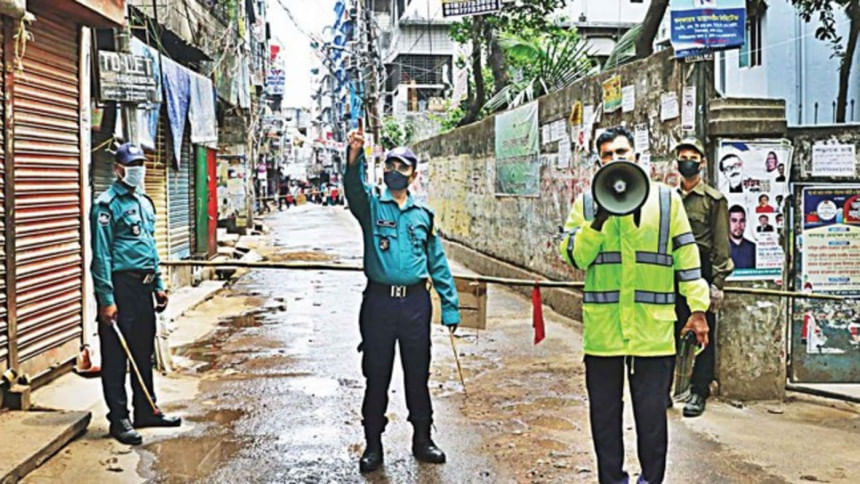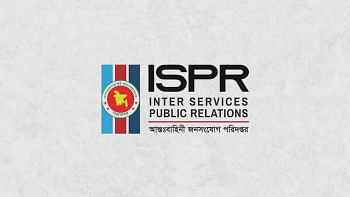Can we make lockdown work this time around?

As the country scrambles to curb the spread of Covid-19, we will be entering yet another lockdown. The current infection rate stands at 23.86 percent, with specific regions crumbling under surmounting pressure to contain the disease. This month alone, Khulna and Rajshahi recorded 295 and 245 Covid deaths, respectively.
Unfortunately, this is not a new scenario. In view of the current situation, the government's decision to look beyond the stop-gap, sporadic locality-wise lockdowns to a more holistic nationwide lockdown is a welcome move. While the next week or two—if the government does indeed fully adhere to the recommendations of the National Technical Advisory Committee on Covid-19 (NTAC)—will be difficult, especially from an economic perspective, it is also expected to help curb the rapid spread of the highly transmissible Delta variant.
The government, at this point, needs to have a broader Covid management strategic plan and map stakeholders accordingly for their involvement in resolving the issues that will surface during the lockdown—complete or partial. They cannot fight this ever-spreading pandemic alone.
In enforcing the lockdown successfully, the government needs to overcome three major challenges. The first will be keeping people indoors, and for this, each and every family whose livelihoods will be affected must be provided with sustenance for the duration of the lockdown. Raising awareness among the grassroots about Covid-19, its transmissibility, its symptoms and why social distancing is necessary, will be another challenge. And the third challenge will be to roll out vaccine programmes at the district level. And none of these will be possible without collaboration with private and development sector actors.
As an immediate measure, the government has said it is working to provide cash and food assistance to families affected by lockdown. The finance minister, in the 2021 fiscal budget, proposed a fund of Tk 10,000 crore that would be used to meet the pandemic's emergency requirements. The prime minister is expected to announce the government's steps in this regard in her concluding budget speech on June 29.
However, past mistakes must not be repeated. Last year, five million affected families were supposed to receive government incentives during the lockdown, but only 3.5 million families did so, apparently due to insufficient data in beneficiary identification. The same challenge might surface again this time. According to noted economist Dr Hossain Zillur Rahman in a previous interview, "A major challenge here, where we all have to contribute, is to target the recipients properly. And here it seems the government is not taking a very useful approach, in the sense that they are mostly looking for support from administrative wings, such as DCs. Also, political actors are being considered to do the listing. However, if you want to make a list of the urban poor, two criteria would be useful to work on: one is focusing on living areas with high concentrations of the urban poor, meaning the slums mostly. We know the physical locations of these places. So, we can move forward in an area-based approach for targeting."
Apart from the Tk 10,000 crore budget allocation, the Asian Development Bank, on June 18, approved a USD 250 million policy-based loan to the Bangladesh government to support the Strengthening Social Resilience Programme. Among other parameters, this programme will "expand its outreach to vulnerable women by increasing the coverage of both the old age allowance for women over 62 and the allowance for widowed, deserted, and destitute women in 150 sub-district units or upazilas". The government must ensure effective distribution of this fund and can also consider expanding the scope of the programme to support families affected by Covid-19.
Moreover, there are multinational and local companies, including banks and development sector actors, who are announcing Covid relief measures of their own. During lockdown, the government can collaborate with these actors and align its own financial assistance programmes with theirs to make them more effective and minimise possibility of irregularities. For this, the government needs to bring onboard these stakeholders with its plan—if there is one in the first place.
Secondly, the government must utilise mass communication tools to raise awareness about Covid-19 at the grassroots levels. For example, a picture in this daily, published on June 26, depicted people in Khulna, one of the worst hit districts, flouting lockdown measures. The report reads, "On the fourth day of the weeklong lockdown, droves of Khulna city residents gathered and crowded at kitchen markets, ignoring health guidelines amid an increasingly worsening situation."
However, people are not adhering to the lockdown for two reasons: either they are not aware of the existence and/or dangers of the pandemic, or they are out in search of livelihoods. To rectify the former, the government needs to roll out a mass communication drive, involving national and private communication channels in both online and offline mediums, to spread awareness on Covid-19, its impact and how every single person can play a role in shielding themselves and their loved ones.
Finally, the government needs to utilise this lockdown window to roll out mass vaccination programmes focusing on affected districts, especially the ones bordering India. The government has already started using the Sinopharm vaccine in 67 centres across the country, after 600,000 doses arrived earlier in June. According to the health minister, the government plans to procure another 10.5 million doses of this vaccine, which will arrive in three instalments over three months. Moreover, on June 1, 1.06 lakh doses of the Pfizer vaccine arrived in the country, and 25 lakh doses of the Moderna vaccine is expected to arrive in the next 10 days.
While the currently available vaccines will not be sufficient to inoculate the entire nation in one go, the government will have to take a strategic vaccination approach in order to make the best use of this opportunity and contain the spread of the Delta variant. Bangladesh has also received USD 500 million in additional financing from the World Bank to strengthen its vaccination programme, which will enable it to vaccinate around 54 million people. The country needs to utilise this fund to ensure maximum inoculation.
However, there remains another major problem: the upcoming Eid-Ul-Adha and the massive cattle and leather trade surrounding it. Experts have shared concerns that if the government allows cattle traders from all over the country to gather in Dhaka, it might expose the capital further to threats of Covid-19 variants. The gathering of thousands of people in cattle markets would further exacerbate the situation. It has been reported that many cattle traders and their animals will come from Kushtia, Meherpur, Chuadanga and Jhenaidah of Khulna division—many of which have turned into Covid-19 hotspots. So far, as reported by this newspaper, around 23 cattle markets will be set up in Dhaka.
According to Department of Livestock Services director-general Sheikh Azizur Rahman, "We've given a proposal to transport cattle on wagon trains if the lockdown is continued." The DNCC mayor has also suggested blocking entry into Dhaka of cattle from highly infected districts. But how will this be implemented?
There is no denying that the government's initial complacency has led to the surmounting challenges today—a mess that could have been avoided with foresight and timely, proactive strategic measures. Whatever initiatives the government chooses to take now to contain the spread of the virus, it is certain that this is not a battle, but a full-fledged war that will require each and every single citizen of this nation to fight from their own position.
Tasneem Tayeb is a columnist for The Daily Star.
Her Twitter handle is: @tasneem_tayeb

 For all latest news, follow The Daily Star's Google News channel.
For all latest news, follow The Daily Star's Google News channel. 



Comments